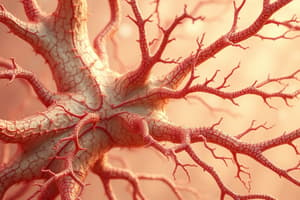Podcast
Questions and Answers
Match the following with their respective characteristics in parasitology samples:
Match the following with their respective characteristics in parasitology samples:
Plasmodium spp. stages = Resemblance: Human white blood cells Strongyloides stercoralis worm = Size range: 8-65 m, Average size: 12-25 m Hookworm filariform larvae = Nucleus: 2–4 segments connected by narrow, short chromatin bands; 15um Vegetable Cells = Exhibits a smooth cytoplasm; does not contain inclusions
Match the following confusers/artifacts with their descriptions:
Match the following confusers/artifacts with their descriptions:
Human Cell Confusers = Resemblance: Polymorphonuclears Plant Origin Confusers = Contains cytoplasmic inclusions like ingested red blood cells, and other fecal debris Yeast, Fungal & Algal material Confusers = These are remnants of ciliated epithelial cells that may be seen from sputum and stool samples Pollen Grains = May be confused with ciliates and flagellates
Match the following with their respective sizes in parasitology samples:
Match the following with their respective sizes in parasitology samples:
Plasmodium spp. stages = 12-18um Strongyloides stercoralis worm = 8-65 m Hookworm filariform larvae = 15um Pollen Grains = Average size: 12-25 m
Match the following descriptions with the correct item:
Match the following descriptions with the correct item:
Match the following items with their distinguishing characteristic:
Match the following items with their distinguishing characteristic:
Match the following items with their resemblance:
Match the following items with their resemblance:
Match the following sizes with the correct item:
Match the following sizes with the correct item:
Match the following items with their internal structures:
Match the following items with their internal structures:
Match the following items with their resemblance:
Match the following items with their resemblance:
Match the following descriptions with the correct organism or material:
Match the following descriptions with the correct organism or material:
Match the following with their resemblance or characteristics:
Match the following with their resemblance or characteristics:
Match the following features with the correct category:
Match the following features with the correct category:
Match the following organisms with their primary characteristics:
Match the following organisms with their primary characteristics:
Match the following findings with their corresponding entity:
Match the following findings with their corresponding entity:
Match the following resemblances with their corresponding entity:
Match the following resemblances with their corresponding entity:
Flashcards are hidden until you start studying




